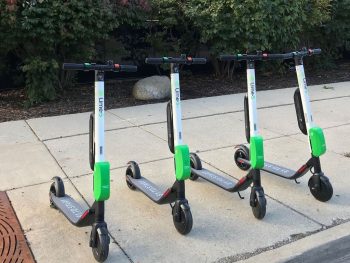Switch to e-scooters could create safer urban roads, report claims
Improving urban environments to enable use of electric scooters and e-bikes could cut the number of cars on roads in European cities, improving road user safety.

The report claims that e-scooter riders do not face significantly higher risk of road traffic death or injury than cyclists
That’s view of inter-governmental organisation, the International Transport Forum at the Organisation for Economic Co-operation and Development (OECD), in its new report on safe micromobility.
The document has been published after an article The Times in the UK indicated that the Department for Transport is to press ahead with a consultation announced last March that could see e-scooters enabled for UK use – currently they’re illegal on UK roads due to the 1988 Road Traffic Act, and regarded as banned on pavements under the 1835 Highway Act.
This has set off alarm bells for road safety organisations, in particular after YouTube star Emily Hartridge became the first electric scooter fatality in the UK last year. However, micromobility solutions – including e-scooters and e-bikes as well as motorised skateboards and other light personal mobility devices – are becoming increasingly popular, in particular in places like San Francisco.
The report from the International Transport Forum examines safety aspects associated with such micro-vehicles and claims that e-scooter riders do not face significantly higher risk of road traffic death or injury than cyclists; although cyclist safety itself is a concern for road safety organisations.
The ITF also says that traffic will be safer if more car and motorbike drivers turn to e-scooter and bicycle trips, pointing to the fact that motor vehicles are involved in 80% of fatal crashes with e-scooters and bicycles.
But the report notes that the fast-paced evolution of micro-vehicles challenges governments to put in place safety regulations that are future-proof and sets out key recommendations for authorities.
Chief to this is allocating protected space for micromobility, through the use of traffic calming or by creating dedicated spaces. It adds that micro-vehicles should be banned from pavements or subject to a low, enforced speed limit.
It also sets out that low-speed micro-vehicles such as e-scooters and e-bikes should be treated as bicycles. Faster micro-vehicles should be regulated as mopeds.
But safety of motor vehicles should also be a focus, and where micro-vehicles are used alongside motor vehicles, speed limits should be 30km/h (19mph) or less. Governments should also tackle drink driving and speeding across all vehicle types.
The ITF report also calls for road safety agencies to collect data on micro-vehicle trips and crashes, including making use of micro-vehicles’ motion sensors and GPS.
Finally, the report urges operators of shared micromobility fleets to ensure their pricing mechanisms do not encourage riders to take risks. By-the-minute rental can be an incentive to speed or to ignore traffic rules.
To access the report on safe micromobility, click here.

